Lazio and Inter met in one of the most important games thus far in the season, both fighting for the second spot in the table, trying to dismiss their point difference from the leaders Juventus.
At first, Inter seemed to have the plan for disarming Lazio’s attack, but after a few changes made by Simone Inzaghi in the second half, the Biancocelesti increased the tempo and fought back deservedly reaching the 2-1 win.
A defensive mistake led to Inter conceding a penalty, letting Ciro Immobile score for 26th time in his 24 games this season. The equaliser boosted Lazio’s confidence and their press resulted in doing a complete turnover and getting the three points.
This tactical analysis aims to break down both teams’ tactics and show how Inzaghi’s in-game changes improved Lazio’s performance immediately, making it harder for the Nerazzurri to resist to their efforts in the final third.
Lineups

Both coaches went for the 3-5-2 set-up. Inzaghi’s side were covered by Thomas Strakosha on the goal and Ştefan Radu, Francesco Acerbi and Luiz Felipe as a back-three. Jony played as a left wing-back accompanied by Luis Alberto, Lucas Leiva, Sergej Milinković-Savić and Adam Marušić in the midfield. The front duo included Ciro Immobile and Felipe Caicedo.
Conte didn’t do any changes in the formation too. Daniele Padelli was on the goal, getting the support of Milan Škriniar, Stefan de Vrij and Diego Godín in defence. The midfield area was covered by Ashley Young, Nicolò Barella, Marcelo Brozović, Matías Vecino and Antonio Candreva. Romelu Lukaku led the attack alongside Lautaro Martínez who got back to Serie A action after a suspension.
Build-up and counter-press similarities
Some similarities in both teams’ build-up phases could be noticed. Lazio tried to trouble Inter’s build-up and force them back, making it hard for them to advance the ball. This strategy helped Lazio in predicting the opposition’s movement and being able to resist it. They applied high press pinning their opponents back and trying to force them into individual mistakes.


Although Lazio managed to limit Inter’s build-up from the back they seemed unprepared when caught on a counter. The home team tried circulating the ball in the midfield area, often using the left flank for short pass combination in efforts to penetrate Inter’s defence.
Inter similarly applied high press and forced their opponents into sending long balls frequently using the goalkeeper who would try to bypass the press by directly sending the ball to the opposition half. Lazio would use the wing-backs as the best passing options and would try to bypass the press by one of them dropping back to pick up the ball and quickly distribute it further.

The Nerazzurri stayed compact as per usual and tried limiting the space between the lines and transitioning as a whole, trying to avoid any gaps and blocking the passing lanes. They were trying to retain possession using the centre defenders, most frequently building up through the Candreva on the right, who would often combine with Vecino in efforts to keep the ball and advance it to the final third.
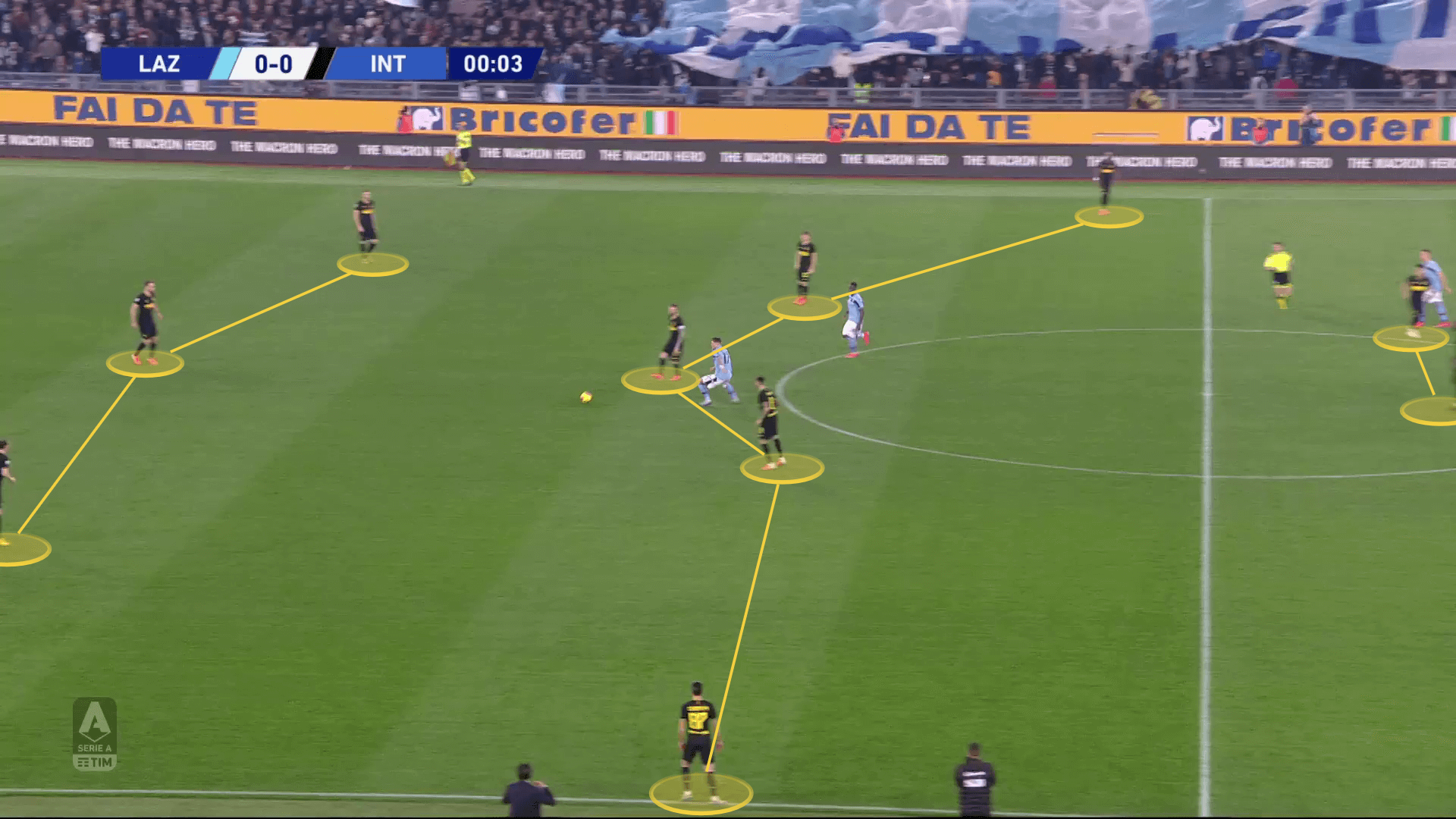
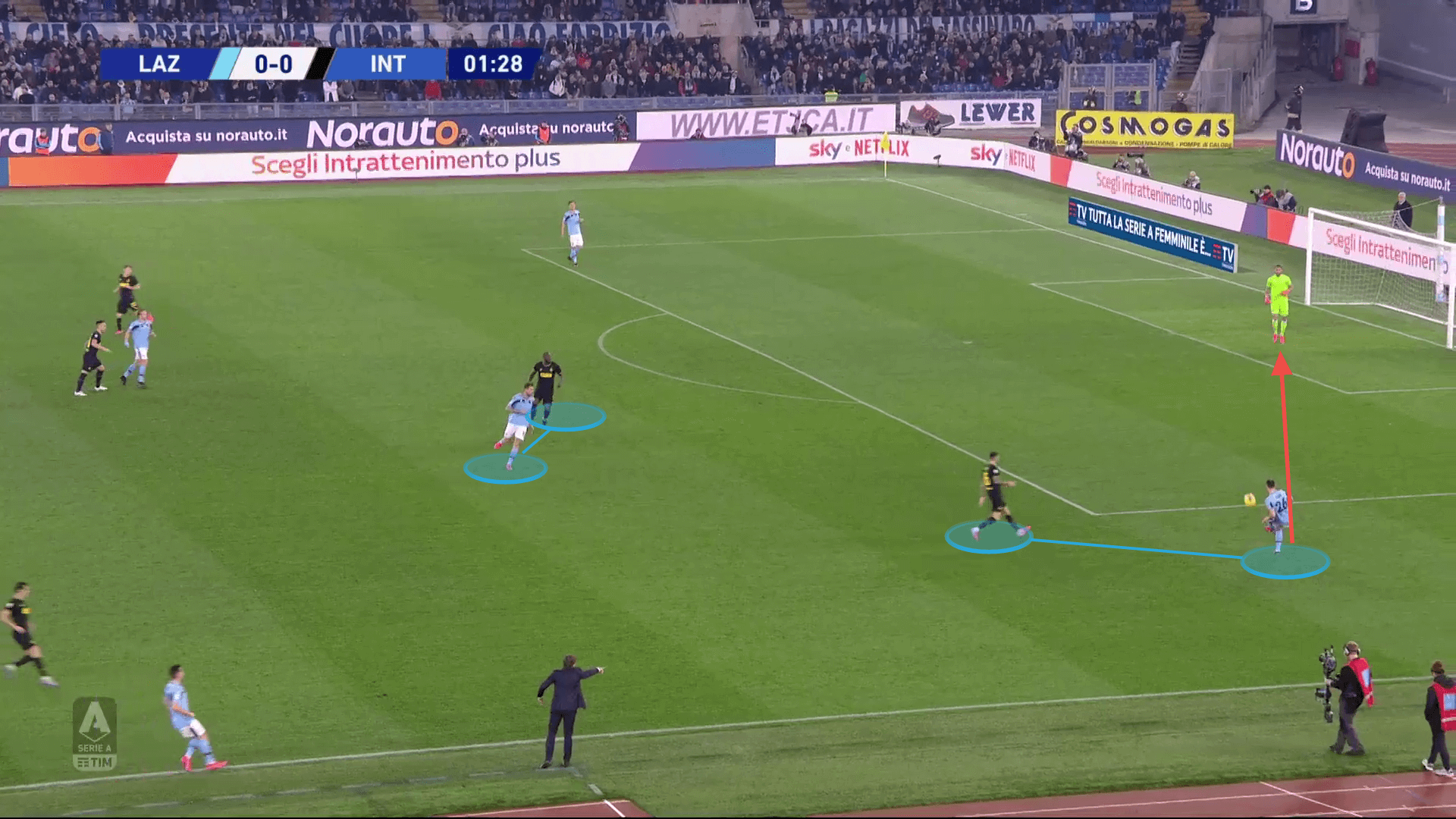
Inter’s strategy for dismissing Lazio’s attacking efforts
Conte adjusted the team’s defensive approach in order to fit the opposition’s attacking strategy pretty successfully. In the first half, Inter were noticeably more focused and able to resist to Lazio’s press, the team’s tactics were pretty clear. Inter’s three-man defence positioned in a way to limit Immobile’s space for movement, with him being the biggest threat for Padelli’s goal.
They made sure to cover the central areas tightly and rely on the midfield players for covering the flanks. They purposively forced Lazio out wide so they can slow down the tempo and be able to cover the opposition players properly. They still used their flat 5-3-2 out of possession on some occasions, but were able to switch quickly depending on Lazio’s attacking approach.

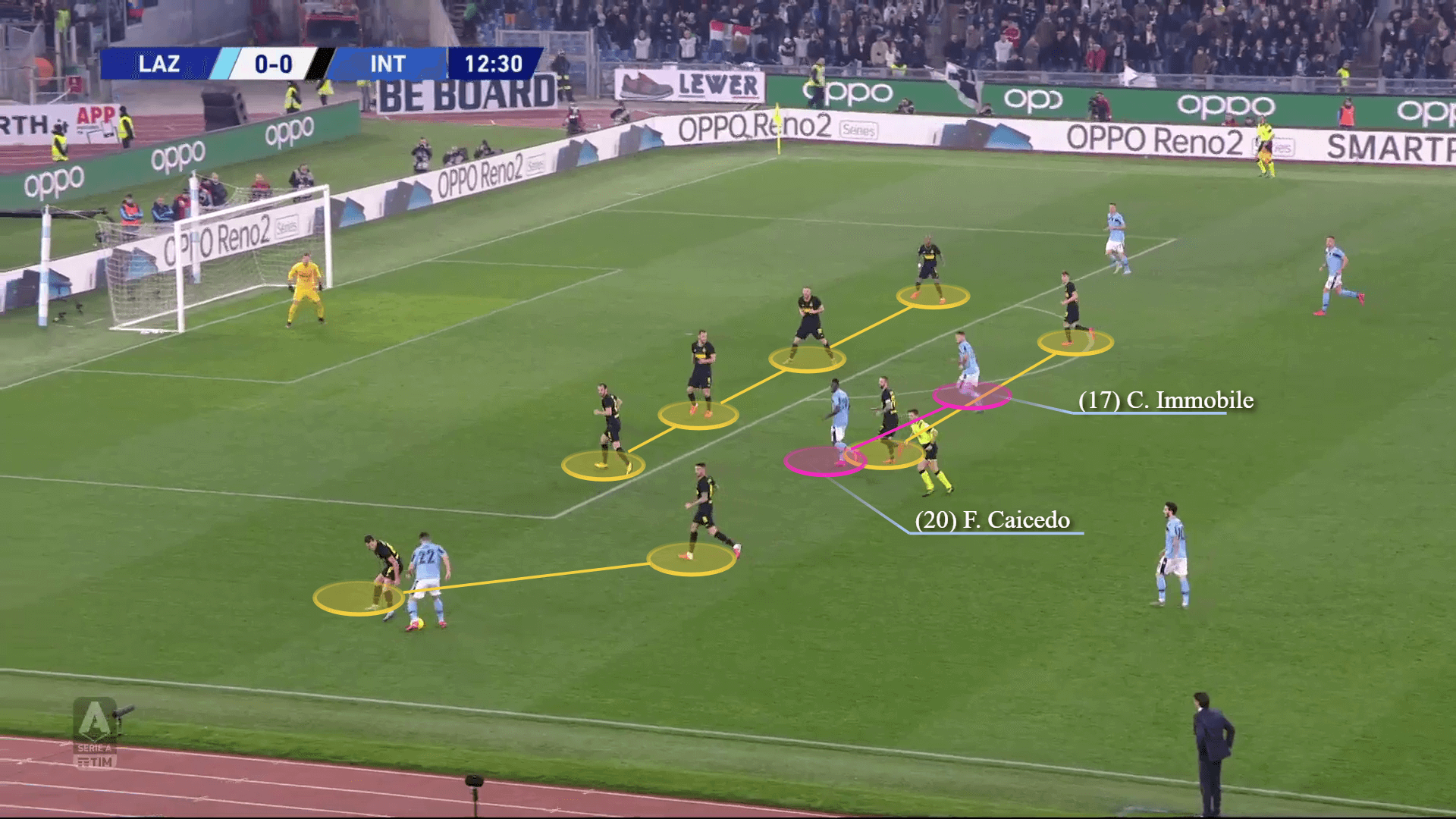
When the central defenders stayed compact centrally, Lazio tried to exploit the wide areas. But Inter’s wing-backs would lead the defensive actions and cover the ball carrier getting support by the other midfield players. The Biancocelesti tried to get the most out of the situation, attacking mostly using the left flank but they would often be stopped right before entering the final third. Inter’s defensive strategy forced Lazio into shooting from distance (45% of their 10 shots were from outside the box).
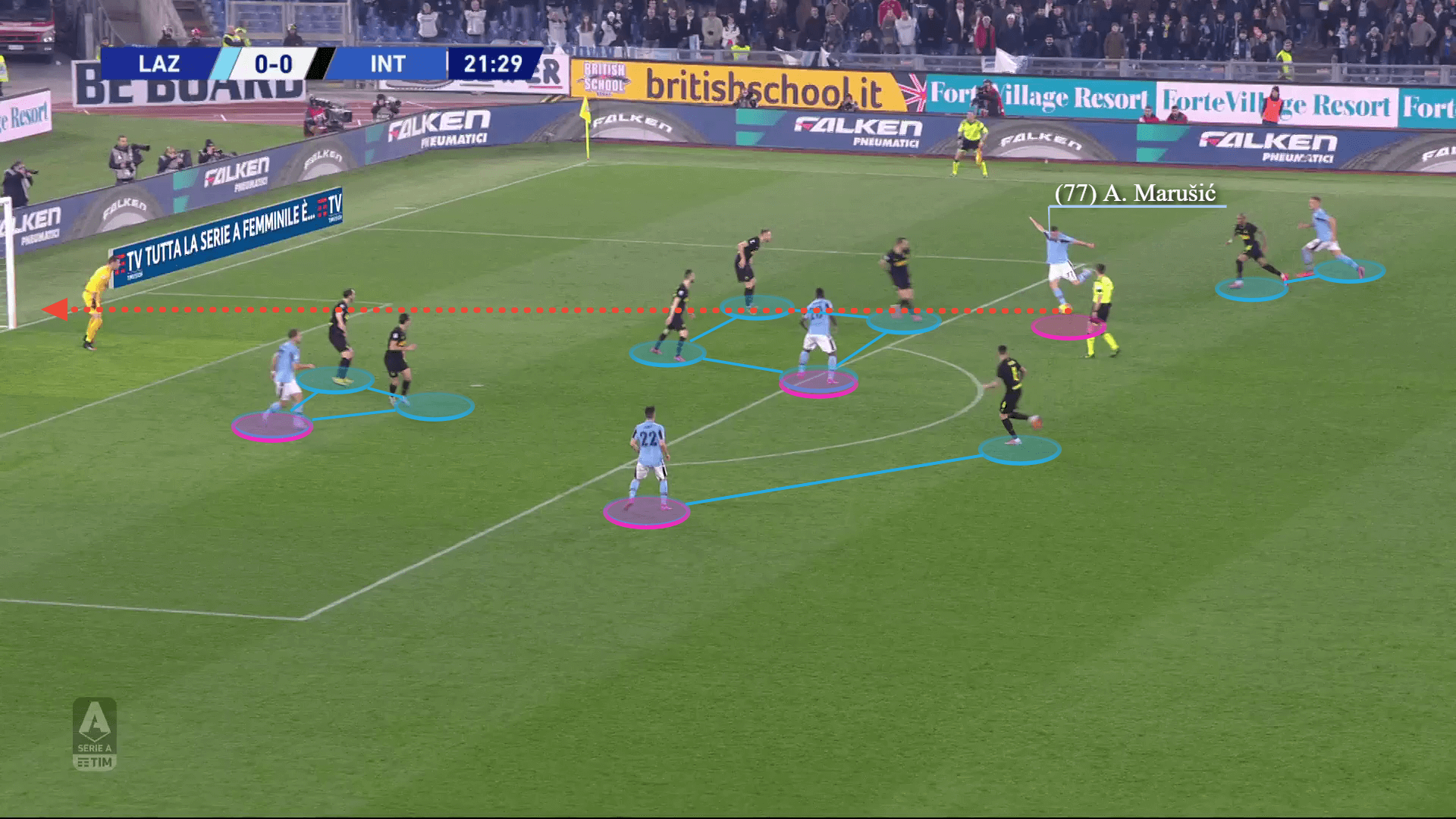

Lazio’s vulnerability on a counter and their defensive actions
It’s not a surprise that Inter were a great threat on a counter. Their efforts and positioning in their own half helped them bypass the press on a few occasions. Since Lazio tried troubling their build-up, the Milan team relied on their speed and positional awareness to catch them off guard and counter. Although Lukaku and Martínez were actively helping in defence, their main responsibility when in their own half was being able to advance the ball immediately after gaining back possession. They created six counters.
Apart from that vulnerability, Lazio’s defensive approach was decent.
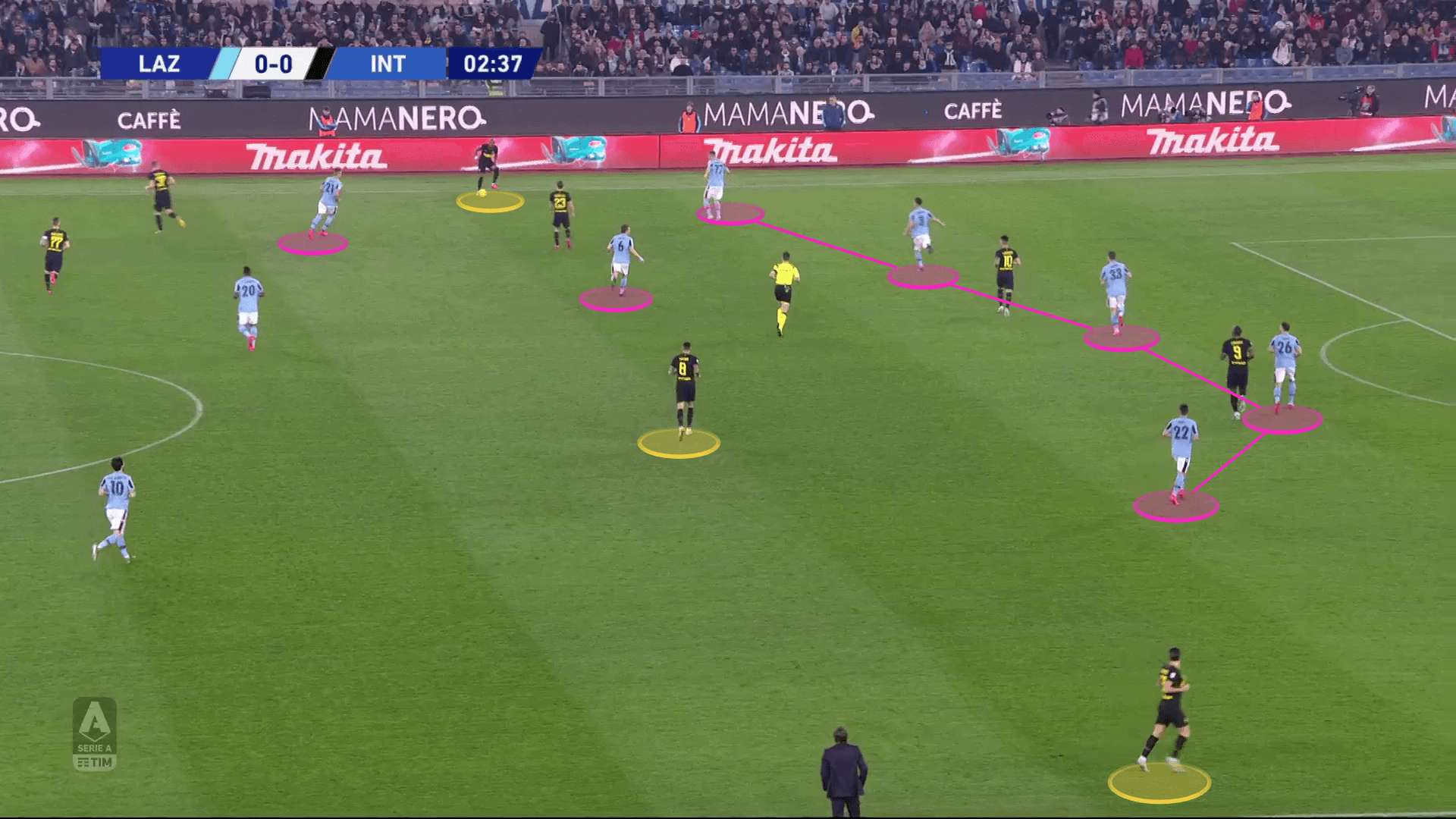

It would be difficult for Lazio to defend when Inter were increasing the pace. Padelli would often have the responsibility to make a quick distribution in order to help the team in attacking on speed. Lukaku, as well as Martínez, would often position out wide and open space for Vecino to operate in. The Belgian would combine with Candreva and drag players out of position allowing Vecino to reach the edge of the box and combine. Lazio’s more direct approach when it comes to tackling has saved them on a few occasions. Once Inter’s attacking efforts were blocked by Lazio’s positioning they’d switch play as per usual trying to bypass the press.


Inzaghi’s in-game changes’ importance
The second half started off with a defensive mistake by Inter, which led to conceding a penalty. Immobile had the responsibility to take it and equalised in the 50th minute. Inzaghi saw that as an opportunity to switch his game plan and try to break Inter’s defensive structure. The lack of wingers affected the team’s attacking ventures in the first half, making them predictable. As mentioned Inter forced them out wide since it was easier to defend the flanks where Lazio didn’t have a real threat. Immobile and Caicedo would help defensively too, but with no one to stay upfront, their transition into attack would be harder.
Once they scored for 1-1, the manager immediately switched to a more aggressive attacking approach. He made a double change, taking off Caicedo who performed poorly throughout the first half and playing Joaquín Correa instead. His second substitution wasn’t the most expected one but was the right one. He replaced Jony for Manuel Lazzari, switching player’s positions. By sending Marušić on the left flank and positioning Lazzari on the right in the role of a right-winger, immediately increased Lazio’s effectiveness upfront. He won all of his offensive duels and made 3/3 successful dribbling attempts.

By committing more players into the attack in the second half, the Roman team created six shots, with four of them being on target. Immobile and Correa showcased their strong partnership, combining off the ball movement and smart passes in efforts to penetrate the defence.

After becoming 1-2 down, Conte made a double change too. He was seeking of a more direct attacking approach too, bringing in Victor Moses and Christian Eriksen, replacing Candreva and Brozović. This wouldn’t improve the team’s attacking actions, which forced the manager to take out the defender Diego Godín in favour of Alexis Sánchez. His changes though seemed a bit late and didn’t lead to any improvement.
Conclusion
Despite the lack of squad depth Inzaghi did his analysis right and outwitted Conte tactically and proved that he might be ready to conquer the top. By the celebrations after the final whistle, it was clear how important was his win for Lazio. It was crucial not only due to the three points, but it also boosted their confidence for the upcoming fixtures. For Inter on the other side, there is no more space for mistakes. Conte’s players sometimes find it hard to adjust to a different approach by the opposition and it is a matter of time for their opponents to start targetting their weaknesses.






Comments